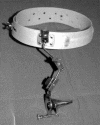Outcome assessment in patients with chronic obstructive rhinitis CO2 laser treated
- PMID: 18383755
- PMCID: PMC2639950
Outcome assessment in patients with chronic obstructive rhinitis CO2 laser treated
Abstract
Surgical lasers have been used to restore nasal flow in chronic obstructive rhinitis, with a significant improvement in symptoms having been reported in almost all cases. However, evidence supporting the efficacy at long-term, and studies on the assessment of quality of life remain limited. In the present study, efficacy at long term and improvement in the quality of life were assessed in patients with chronic obstructive rhinitis, treated with CO2 laser. A total of 308 patients with chronic obstructive rhinitis were enrolled. The primary outcome measure assessed was the change in score regarding specific and general symptoms, between baseline to 2-4.5 and 7.8 mean years follow-up. Laser turbinotomy restored nasal flow and induced a change in total score which was statistically significant, for specific and general symptoms at the first, second and third follow-up, p < 0.01. CO2 laser turbinate surgery improved symptoms and quality of life in patients with chronic obstructive rhinitis as observed at 2-4.5 and 7.8 mean years follow-up.
La chirurgia laser è stata impiegata nel ripristino della pervietà nasale nei soggetti affetti da rinite cronica ostruttiva (COR); la maggior parte degli Autori riporta un significativo miglioramento della sintomatologia. Sono tuttavia pochi gli studi che ne supportino l’efficacia a lungo termine e che valutino l’impatto sulla qualità di vita (QoL). Gli Autori hanno valutato i risultati a lungo termine e la QoL nei pazienti affetti da COR, trattati con il laser a CO2. Sono stati inclusi nello studio 308 pazienti con rinite cronica ostruttiva. Il principale parametro di valutazione di efficacia è stato il cambiamento in termini di score sintomatologico, per i sintomi generali e specifici, tra il tempo zero, il primo, secondo e terzo follow-up (tempo medio 2-4,5 e 7,8 anni). Lo studio evidenzia che la turbinotomia effettuata con il laser a CO2 ripristina il flusso respiratorio nasale ed induce modifiche statisticamente significative negli score totali per i sintomi generali e specifici al primo, secondo e terzo follow-up, migliorando la QoL.
Figures






Similar articles
-
Carbon dioxide laser turbinate surgery for chronic obstructive rhinitis.Lasers Surg Med. 2000;27(1):49-54. doi: 10.1002/1096-9101(2000)27:1<49::aid-lsm7>3.0.co;2-y. Lasers Surg Med. 2000. PMID: 10918293
-
Swiftlase inferior turbinoplasty.Am J Rhinol. 1999 Nov-Dec;13(6):479-82. doi: 10.2500/105065899781329638. Am J Rhinol. 1999. PMID: 10631406 Clinical Trial.
-
Rhinitis medicamentosa: therapeutic effect of diode laser inferior turbinate reduction on nasal obstruction and decongestant abuse.Am J Rhinol. 2008 Jul-Aug;22(4):433-9. doi: 10.2500/ajr.2008.22.3199. Am J Rhinol. 2008. PMID: 18702912
-
[Treatment of nasal obstruction with subtotal inferior turbinectomy in chronic rhinitis: a retrospective study on 50 patients].Ann Otolaryngol Chir Cervicofac. 1998 Oct;115(4):228-33. Ann Otolaryngol Chir Cervicofac. 1998. PMID: 9827190 Review. French.
-
Surgical options for the allergic rhinitis patient.Curr Opin Otolaryngol Head Neck Surg. 2012 Jun;20(3):199-204. doi: 10.1097/MOO.0b013e328352b821. Curr Opin Otolaryngol Head Neck Surg. 2012. PMID: 22487786 Review.
Cited by
-
CO₂ Laser for the Treatment of Auricle Schwannoma: A Case Report and Review of the Literature.Am J Case Rep. 2019 Jul 9;20:988-992. doi: 10.12659/AJCR.916714. Am J Case Rep. 2019. PMID: 31287809 Free PMC article. Review.
-
Our experience in the treatment of Malignant Fibrous Hystiocytoma of the larynx: clinical diagnosis, therapeutic approach and review of literature.Open Med (Wars). 2016 Jun 23;11(1):208-214. doi: 10.1515/med-2016-0040. eCollection 2016. Open Med (Wars). 2016. PMID: 28352796 Free PMC article.
-
Cavernous hemangioma of rhinopharynx: our experience and review of literature.Open Med (Wars). 2015 Dec 17;10(1):523-528. doi: 10.1515/med-2015-0089. eCollection 2015. Open Med (Wars). 2015. PMID: 28352748 Free PMC article.
-
Office-Based Blue Laser Versus Coblation Therapy for Inferior Turbinate Hypertrophy: A Pilot Study.OTO Open. 2025 May 14;9(2):e70127. doi: 10.1002/oto2.70127. eCollection 2025 Apr-Jun. OTO Open. 2025. PMID: 40370997 Free PMC article.
References
-
- Englender M. Nasal laser mucotomy (L-mucotomy) of the inferior turbinates. J Laryngol Otol 1995;22:151-5. - PubMed
-
- Kamami YV, Pandraup L, Bougara A. Laser-assisted outpatient septoplasty: Results in 703 patients. Otolaryngol Head Neck Surg 2000;122:445-9. - PubMed
-
- Ossoff RH, Reinish L. Laser application in otolaryngology. Clin North Am 1996;29:891-914. - PubMed
-
- Testa B, Mesolella M, Squeglia C, Testa D, Motta G. Carbon dioxide laser turbinate surgery for chronic obstructive rhinitis. Lasers Surg Med 2000;27:49-54. - PubMed
-
- Katz S, Schmelzer B, Vidts G. Treatment of the obstructive nose by CO2 – Laser reduction of the inferior turbinates: technique and results. Am J Rhinol 2000;14:51-5. - PubMed
MeSH terms
Substances
LinkOut - more resources
Full Text Sources
